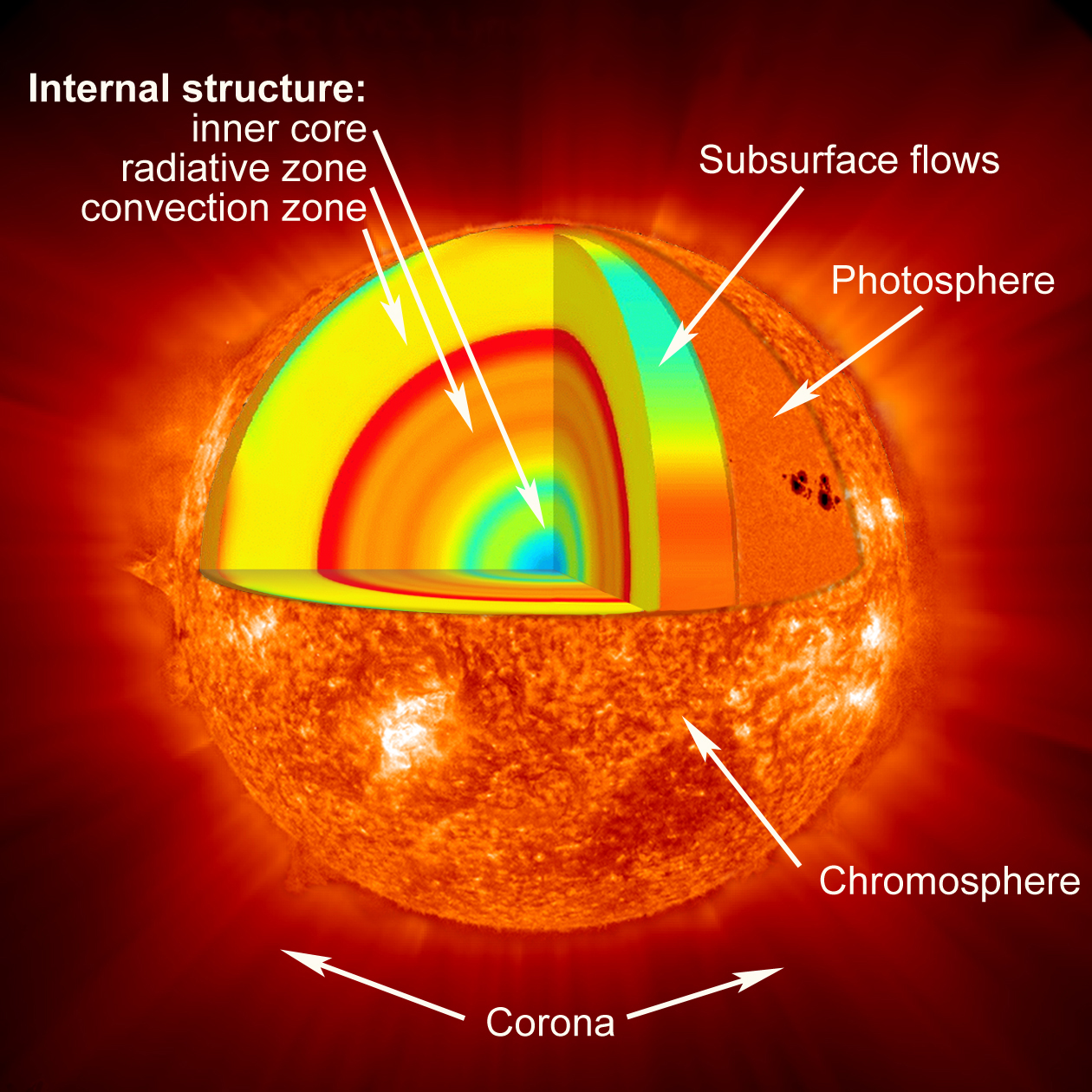Ah the sun. It gave me a really bad sunburn when I went on holiday, so bad that both my ankles swelled, it hurt to walk, move, or breathe, and I only really walked when I wanted to wander towards the buffet. So I have learnt the hard way that the sun is something that should be respected, perhaps even feared.

Following the diagram above to give an idea of what the sun is made up of, what we can't see here is that the sun is made up of different elements including hydrogen, helium, and the remainder is oxygen, silicon, chromium, calcium, magnesium, nickel and carbon. Being this big ball of gases, these gases are converted into energy in the sun's core. The energy moves outward through the interior layers into the sun's atmosphere and is released into the solar system as heat and light. Nuclear fusion converts hydrogen into other elements. What occurs is that these elements are created in the sun's core, which makes up 25 percent of the sun. Gravitational forces create tremendous pressure and temperatures in the core. The temperature of the sun in this layer is about 27 million degrees and hydrogen atoms are compressed and fuse together, creating helium and a lot of energy.
The energy, in the form of gamma-ray photons and neutrinos, is carried into the radiative zone where photons can bounce around in this zone for about a million years before passing through the interface layer, or tachocline.
The convection zone is the outermost layer of the sun's interior where temperatures cool in this zone. This causes heavier ions such as carbon, nitrogen, oxygen, calcium and iron to hold onto their electrons which makes the material more opaque and traps heat, causing the plasma to boil or 'convect'. The convective motions carry heat quite rapidly to the surface, which is the bottom layer of the sun's atmosphere, or photosphere. At this layer, energy is released as sunlight. The light passes through the outer layers of the sun's atmosphere — the chromosphere and the corona — before reaching Earth eight minutes later.
So what would happen if the Sun wasn't there?
Spaceanswers state that it is a question that can only be looked at hypothetically from the perspective of the motion of bodies in the Solar System. So anything in orbit around the Sun is basically moving fast enough to be in a constant state of freefall towards it. If the planets, for example, suddenly stopped moving they would immediately be pulled towards the Sun and fall into it.
So if the Sun disappeared all the planets, asteroids, comets and whatever else would retain their forward motion and consequently, they would fly off in a straight line into space.Some planets might gravitationally interact with one another, especially as the inner planets are moving faster than the outer planets and would potentially ‘catch up’ to them. Otherwise, the likelihood is all the objects would continue to move in a straight line through space out of the Solar System, and it would be many thousands of years before they came into the vicinity of another system or object.
On Earth, as our planet retains heat rather well, we wouldn’t freeze to death instantly. Also, as light from the Sun takes eight and a half minutes to reach us, there would still be some sunshine before the planet is plunged into darkness.Those on the night side wouldn’t notice much difference until, a few seconds after people on the other side of Earth are plunged into darkness, the Moon would suddenly disappear as it no longer had the Sun’s light to reflect. The planets in the sky would follow suit, disappearing one by one.Eventually, the lack of the Sun’s radiation would leave us cold. Within days, the world would be a hundred or so degrees below freezing, and within weeks it’d be just 50 or so degrees above absolute zero. The atmosphere itself would also freeze and fall to Earth, leaving us exposed to the harsh radiation travelling through space.
Some microorganisms would be able to survive due to heat from the core and for humans, nuclear fusion reactors would be a necessity to survive a little longer.
So, if you ever were wondering the answer to this question, there's the answer! And if you want to write an end-of-the-world novel or script on the end of Earth due to the death of Sun, there's the (hypothetical) facts on what will happen. Thanks for reading!
No comments:
Post a Comment